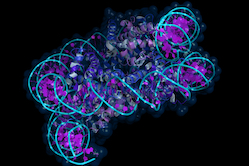Rolling back the frontiers: new insights into how genes operate
Cells respond to their environment through gene regulation involving protein transcription factors. Transcription, the mechanism controlling gene expression, is regulated through binding factors to gene promoters causing them to activate or repress expression. Although central to our understanding of how genes are controlled, the mechanisms by which factors find targets remain unclear. Advanced super-resolution microscopy shows our genes are controlled by clusters of chemicals forming ‘nano footballs’, opening up research into what researchers term ‘the underexplored and novel aspect of gene regulation’ through technology that has not been available until recently. Researchers based at the University of York, two of whom have received support from the EU-funded ISOLATE project, have just published a paper titled, ‘Transcription factor clusters regulate genes in eukaryotic cells’. In it they set out their discovery that, they state, addresses the long-standing question of how transcription factors efficiently find their targets. Using single-molecule fluorescence microscopy, the team gained what lead researcher Professor Mark Leake, Chair of Biological Physics at the University of York, described as the ‘breathtaking’ ability to see into cells, one molecule at a time. The team believes the clustering process is due to an ingenious strategy the cell uses to allow transcription factors to reach their target genes as quickly as possible. The fact that the size of these nano footballs matches the gaps between DNA when it is packed tightly inside a cell, they feel, is not coincidental. The DNA is squeezed into cells, leaving little gaps between separate strands resembling the mesh in a fishing net. The size of the mesh is very close to the size of the nano footballs the researchers identified. Professor Leake told Science Daily ‘This means that nano footballs can roll along segments of DNA but then hop to another nearby segment. This allows the nano football to find the specific gene it controls much more quickly than if no nano hopping was possible. In other words, cells can respond as quickly as possible to signals from the outside, which is an enormous advantage in the fight for survival.’ Researchers hope their findings may have important mechanistic implications for the understanding of amyloid plaques found in neurodegenerative disorders including Alzheimer’s and Parkinson’s diseases. Increased knowledge of the clustering mechanism may not only be of value in understanding such diseases, but could enable future novel synthetic biology applications to manufacture gene circuits with, for example, a range of bespoke response times. ISOLATE (Developing single cell technologies for systems biology) was an Initial Training Network involving eleven trainees on a program ranging from forefront microtechnology, bioengineering, biophysics, via analytical chemistry to biochemistry and systems biology. For more information, please see: CORDIS project web page
Countries
Sweden, United Kingdom



